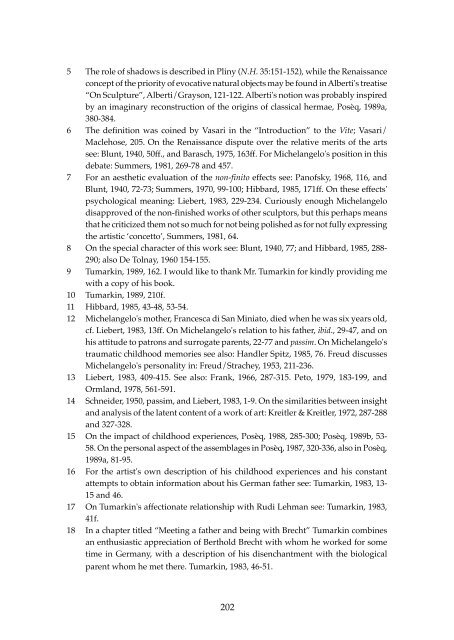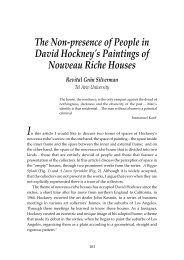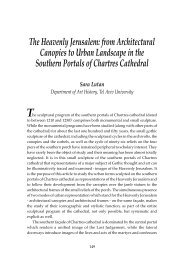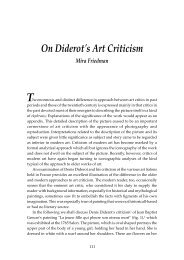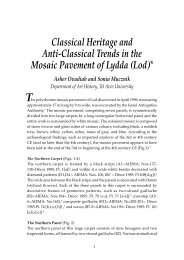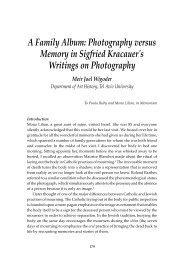Tumarkin's Homage to the Pietà Rondanini Avigdor WG Posèq
Tumarkin's Homage to the Pietà Rondanini Avigdor WG Posèq
Tumarkin's Homage to the Pietà Rondanini Avigdor WG Posèq
You also want an ePaper? Increase the reach of your titles
YUMPU automatically turns print PDFs into web optimized ePapers that Google loves.
5 The role of shadows is described in Pliny (N.H. 35:151-152), while <strong>the</strong> Renaissance<br />
concept of <strong>the</strong> priority of evocative natural objects may be found in Alberti's treatise<br />
“On Sculpture”, Alberti/Grayson, 121-122. Alberti's notion was probably inspired<br />
by an imaginary reconstruction of <strong>the</strong> origins of classical hermae, <strong>Posèq</strong>, 1989a,<br />
380-384.<br />
6 The definition was coined by Vasari in <strong>the</strong> “Introduction” <strong>to</strong> <strong>the</strong> Vite; Vasari/<br />
Maclehose, 205. On <strong>the</strong> Renaissance dispute over <strong>the</strong> relative merits of <strong>the</strong> arts<br />
see: Blunt, 1940, 50ff., and Barasch, 1975, 163ff. For Michelangelo's position in this<br />
debate: Summers, 1981, 269-78 and 457.<br />
7 For an aes<strong>the</strong>tic evaluation of <strong>the</strong> non-fini<strong>to</strong> effects see: Panofsky, 1968, 116, and<br />
Blunt, 1940, 72-73; Summers, 1970, 99-100; Hibbard, 1985, 171ff. On <strong>the</strong>se effects'<br />
psychological meaning: Liebert, 1983, 229-234. Curiously enough Michelangelo<br />
disapproved of <strong>the</strong> non-finished works of o<strong>the</strong>r sculp<strong>to</strong>rs, but this perhaps means<br />
that he criticized <strong>the</strong>m not so much for not being polished as for not fully expressing<br />
<strong>the</strong> artistic ‘concet<strong>to</strong>’, Summers, 1981, 64.<br />
8 On <strong>the</strong> special character of this work see: Blunt, 1940, 77; and Hibbard, 1985, 288-<br />
290; also De Tolnay, 1960 154-155.<br />
9 Tumarkin, 1989, 162. I would like <strong>to</strong> thank Mr. Tumarkin for kindly providing me<br />
with a copy of his book.<br />
10 Tumarkin, 1989, 210f.<br />
11 Hibbard, 1985, 43-48, 53-54.<br />
12 Michelangelo's mo<strong>the</strong>r, Francesca di San Minia<strong>to</strong>, died when he was six years old,<br />
cf. Liebert, 1983, 13ff. On Michelangelo's relation <strong>to</strong> his fa<strong>the</strong>r, ibid., 29-47, and on<br />
his attitude <strong>to</strong> patrons and surrogate parents, 22-77 and passim. On Michelangelo's<br />
traumatic childhood memories see also: Handler Spitz, 1985, 76. Freud discusses<br />
Michelangelo's personality in: Freud/Strachey, 1953, 211-236.<br />
13 Liebert, 1983, 409-415. See also: Frank, 1966, 287-315. Pe<strong>to</strong>, 1979, 183-199, and<br />
Ormland, 1978, 561-591.<br />
14 Schneider, 1950, passim, and Liebert, 1983, 1-9. On <strong>the</strong> similarities between insight<br />
and analysis of <strong>the</strong> latent content of a work of art: Kreitler & Kreitler, 1972, 287-288<br />
and 327-328.<br />
15 On <strong>the</strong> impact of childhood experiences, <strong>Posèq</strong>, 1988, 285-300; <strong>Posèq</strong>, 1989b, 53-<br />
58. On <strong>the</strong> personal aspect of <strong>the</strong> assemblages in <strong>Posèq</strong>, 1987, 320-336, also in <strong>Posèq</strong>,<br />
1989a, 81-95.<br />
16 For <strong>the</strong> artist's own description of his childhood experiences and his constant<br />
attempts <strong>to</strong> obtain information about his German fa<strong>the</strong>r see: Tumarkin, 1983, 13-<br />
15 and 46.<br />
17 On <strong>Tumarkin's</strong> affectionate relationship with Rudi Lehman see: Tumarkin, 1983,<br />
41f.<br />
18 In a chapter titled “Meeting a fa<strong>the</strong>r and being with Brecht” Tumarkin combines<br />
an enthusiastic appreciation of Berthold Brecht with whom he worked for some<br />
time in Germany, with a description of his disenchantment with <strong>the</strong> biological<br />
parent whom he met <strong>the</strong>re. Tumarkin, 1983, 46-51.<br />
202


